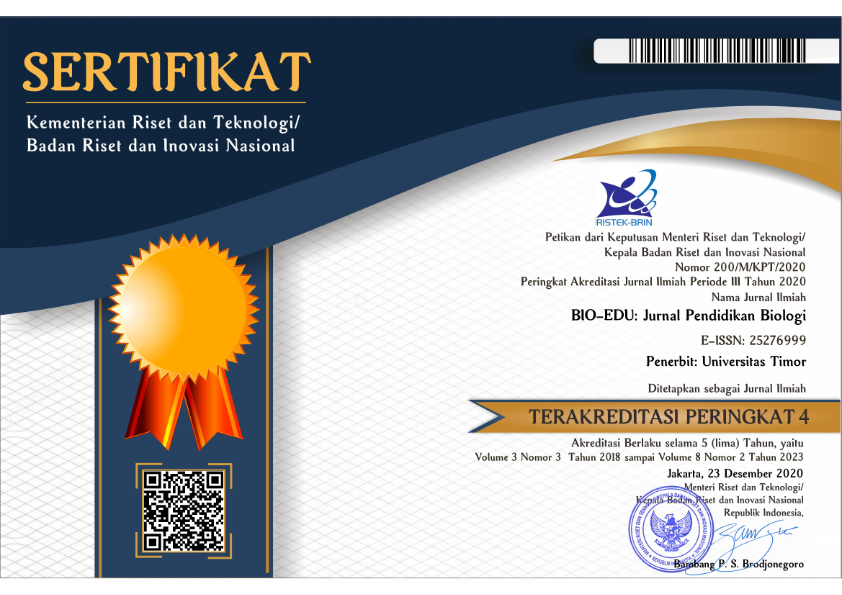Isolasi dan Identifikasi Molekular Bakteri Asam Laktat Penghasil Antimikrobia dari Saluran Pencernaan Belut (Monopterus albus)
Isolasi dan Identifikasi Molekular Bakteri Asam Laktat Penghasil Antimikrobia dari Saluran Pencernaan Belut (Monopterus albus)
DOI:
https://doi.org/10.32938/jbe.v6i3.1277Keywords:
bakteri asam laktat, belut (Monopterus albus), antimikroba, gen 16s rRNAAbstract
Isolasi bakteri asam laktat menggunakan sampel saluran pencernaan belut (Monopterus albus). Belut yang digunakan diperoleh dari pasar Yogyakarta. Hasil isolasi diperoleh sebanyak tigabelas isolat, bakteri hasil isolasi selanjutnya dikarakterisasi secara fenotipik untuk memilih bakteri asam laktat. Hasil karakterisasi fenotipik diperoleh tujuh isolat yang sesuai dengan karakter bakteri asam laktat (ciri bakteri asam laktat bersifat gram positif dan katalase negatif). Tujuh isolat tersebut kemudian diuji kemampuannya dalam menghambat pertumbuhan bakteri patogen (Aeromonas hydrophila, Staphylococcus aureus, dan Vibrio harveyi). Hasil yang diperoleh menunjukkan bahwa tujuh isolat bakteri asam laktat memiliki aktivitas antimikroba yang mampu menghambat pertumbuhan bakteri patogen. Penghambatan terhadap bakteri uji mengindikasikan bahwa bakteri tersebut mampu menghasilkan antimikrobia. Tiga terbaik dari tujuh isolat bakteri diidentifikasi secara molekular menggunakan gen 16Sr RNA dengan primer 27F (5'-AGAGTTTAGTCCTGGCTCAG-3') dan 1492R (5'-GGTTACCTTGTTACGACTT-3'). Hasil yang diperoleh menunjukkan bahwa tiga isolat bakteri merupakan spesies Lactococcus lactis.
References
Aween, Mohamed Mustafa, Zaiton Hassan, Belal J Muhialdin, Hanina Mohd Noor, Yossra A Eljamel, Negeri Sembilan, and U P M Serdang. 2012. “Evaluation on Antibacterial Activity of Lactobacillus Acidophilus Strains Isolated from Honey Department of Microbiology , Faculty of Science and Technology , Universiti Sains Islam Malaysia ( USIM ) Bandar Baru Nilai , Faculty of Science , University Put.” American Journal of Applied Sciences 9 (6): 807–17.
Bajpai, Vivek K., Jeong Ho Han, Gyeong Jun Nam, Rajib Majumder, Chanseo Park, Jeongheui Lim, Woon Kee Paek, Irfan A. Rather, and Yong Ha Park. 2016. “Characterization and Pharmacological Potential of Lactobacillus Sakei 1I1 Isolated from Fresh Water Fish Zacco Koreanus.” DARU, Journal of Pharmaceutical Sciences 24 (1): 1–12. https://doi.org/10.1186/s40199-016-0147-8.
Bintsis, T. 2018. “Lactic Acid Bacteria: Their Applications in Foods.” Journal of Bacteriology & Mycology: Open Access 6 (2): 89–94. https://doi.org/10.15406/jbmoa.2018.06.00182.
Buntin, Nirunya, Suphitchaya Chanthachum, and Tipparat Hongpattarakere. 2008. “Screening of Lactic Acid Bacteria from Gastrointestinal Tracts of Marine Fish for Their Potential Use as Probiotics.” Prince of Songkla University, Hat Yai, Songkhla.
Gatesoupe, François Joël. 2007. “Updating the Importance of Lactic Acid Bacteria in Fish Farming: Natural Occurrence and Probiotic Treatments.” Journal of Molecular Microbiology and Biotechnology 14 (1–3): 107–14. https://doi.org/10.1159/000106089.
Geneaid. 2017. “Presto TM Mini GDNA Bacteria Kit.” Geneaid 004: 1–8.
Kato, Charles, Mark Mugaanyi, Samuel Majalija, Andrew Tamale, Nathan Musisi, and Asuman Sengooba. 2016. “Isolation and Identification of Potential Probiotics Bacteria from the Gut of Oreochromis Niloticus and Clarias Gariepinus in Uganda.” British Microbiology Research Journal 17 (5): 1–8. https://doi.org/10.9734/bmrj/2016/29721.
Kumar, Sudhir, Glen Stecher, Michael Li, Christina Knyaz, and Koichiro Tamura. 2018. “MEGA X: Molecular Evolutionary Genetics Analysis across Computing Platforms.” Molecular Biology and Evolution 35 (6): 1547–49. https://doi.org/10.1093/molbev/msy096.
Lawalata, Helen Joan, Langkah Sembiring, and Endang Sutriswati Rahayu. 2015. “Molecular Identifcation of Lactic Acid Bacteria Producing Antimicrobial Agents from Bakasang, An Indonesian Traditional Fermented Fish Product.” Indonesian Journal of Biotechnology 16 (2): 93. https://doi.org/10.22146/ijbiotech.16368.
Mcginnis, Scott, and Thomas L Madden. 2004. “BLAST : At the Core of a Powerful and Diverse Set of Sequence Analysis Tools” 32: 20–25. https://doi.org/10.1093/nar/gkh435.
Merrifield, Daniel L., and Einar Ringø. 2014. “Aquaculture Nutrition: Gut Health, Probiotics and Prebiotics.” Aquaculture Nutrition: Gut Health, Probiotics and Prebiotics, 1–465. https://doi.org/10.1002/9781118897263.
Mithun, Sarangdhar, Vora Dipak, and Sarang Sheela. 2015. “Screening and Characterization of Novel Bacteriocin Producing Lactobacilli Obtained From Raw Milk Samples.” World Journal of Pharmaceutical Research World Journal of Pharmaceutical Research SJIF Impact Factor Research Article ISSN 4045 (4): 2277–7105.
Nikoskelainen, Sami, Seppo Salminen, Göran Bylund, and Arthur C. Ouwehand. 2001. “Characterization of the Properties of Human- and Dairy-Derived Probiotics for Prevention of Infectious Diseases in Fish.” Applied and Environmental Microbiology 67 (6): 2430–35. https://doi.org/10.1128/AEM.67.6.2430-2435.2001.
Nursyirwani, Nursyirwani, Widya Asmara, Agnesia Endang Tri Hastuti Wahyuni, Triyanto Triyanto, Muhammad Fauzi, and Zainal Abidin Muchlisin. 2017. “Phenotype and Genotype of Lactic Acid Bacteria (LAB) Isolated from the Tiger Grouper Epinephelus Fuscoguttatus Alimentary Tract.” F1000Research 6 (0): 1–14. https://doi.org/10.12688/f1000research.12734.1.
Sari, Rohmah Anita, Risa Nofiani, Puji Ardiningsih. 2012. “KARAKTERISASI BAKTERI ASAM LAKTAT GENUS Leuconostoc DARI PEKASAM ALE-ALE HASIL FORMULASI SKALA LABORATORIUM.” Jurnal Kimia 1 (1 ISSN 2302-1077): 14–20.
Syahputra, A. 2016. “Evaluasi Metode Isolasi Asam Nukleat Dalam Deteksi PCR Untuk Patogen Antraknosa, Bulai, Huanglongbing Dan Mosaik,” 1–59.
Vasiee, A. R., F. Tabatabaei Yazdi, A. Mortazavi, and M. R. Edalatian. 2014. “Isolation, Identification and Characterization of Probiotic Lactobacilli Spp. from Tarkhineh.” International Food Research Journal 21 (6): 2487–92. https://doi.org/10.4172/2327-5073.C1.019.
Verschuere, Laurent, Geert Rombaut, Patrick Sorgeloos, and Willy Verstraete. 2000. “Probiotic Bacteria as Biological Control Agents in Aquaculture.” Microbiology and Molecular Biology Reviews 64 (4): 655–71. https://doi.org/10.1128/mmbr.64.4.655-671.2000.
Downloads
Published
Issue
Section
License
The Authors submitting a manuscript do so on the understanding that if accepted for publication, the copyright of the article shall be assigned to BIO-EDU: Jurnal Pendidikan Biologi and Departement of Biology Education, Universitas Timor as the publisher of the journal. Copyright encompasses rights to reproduce and deliver the article in all form and media, including reprints, photographs, microfilms, and any other similar reproductions, as well as translations.
BIO-EDU journal and Departement Biology Education, Universitas Timor, and the Editors make every effort to ensure that no wrong or misleading data, opinions, or statements be published in the journal. In any way, the contents of the articles and advertisements published in BIO-EDU are the sole and responsibility of their respective authors and advertisers.
Users of this website will be licensed to use materials from this website following the Creative Commons Attribution-ShareAlike 4.0 International License.



















